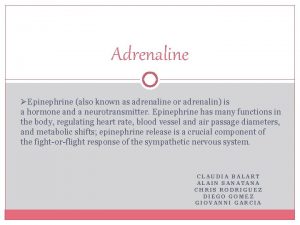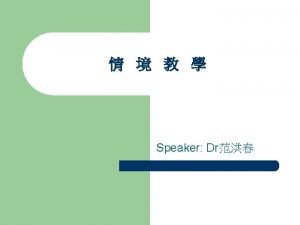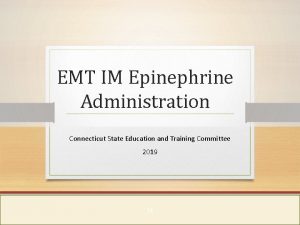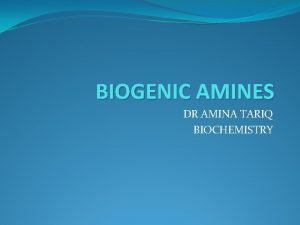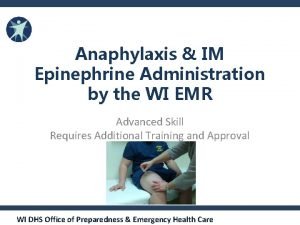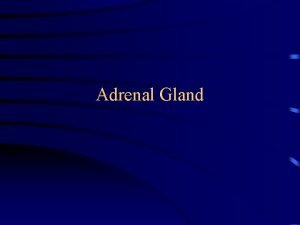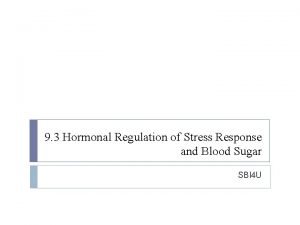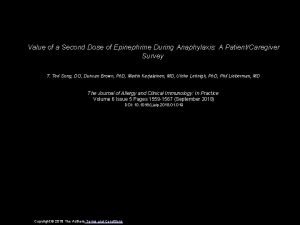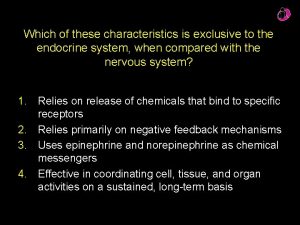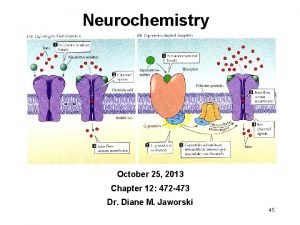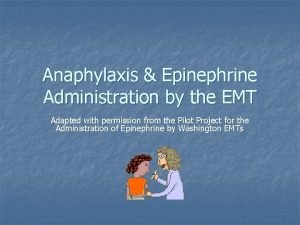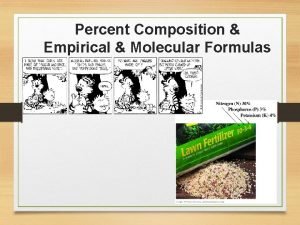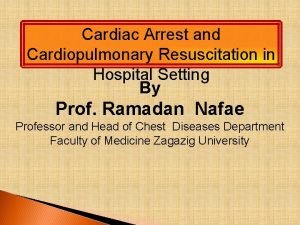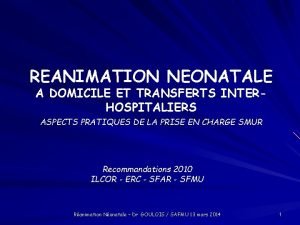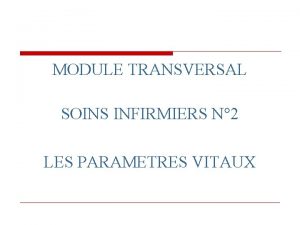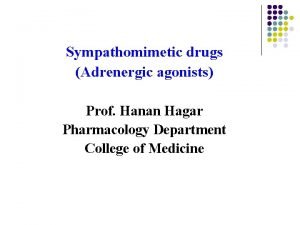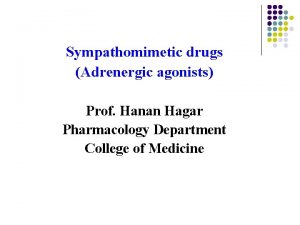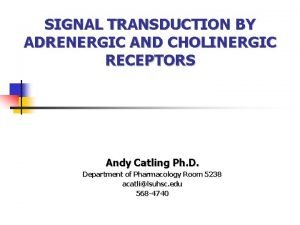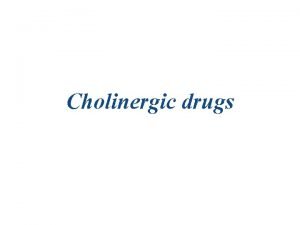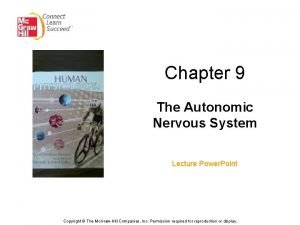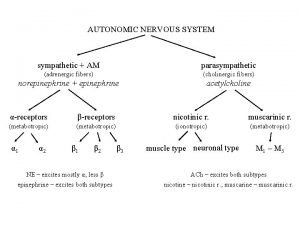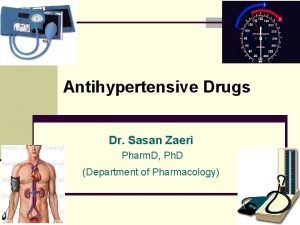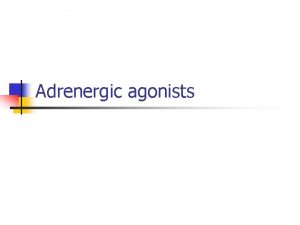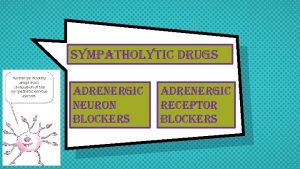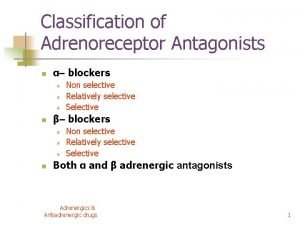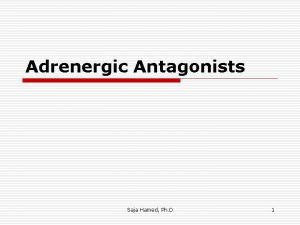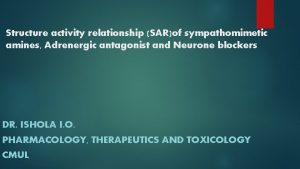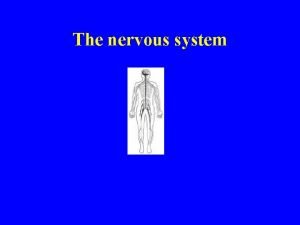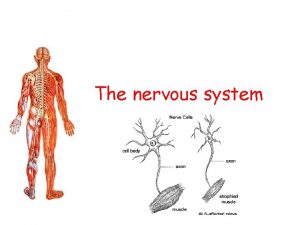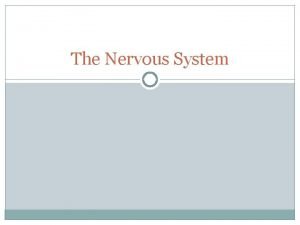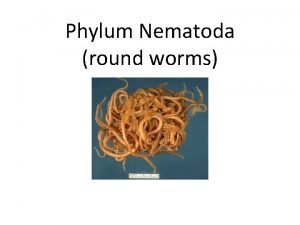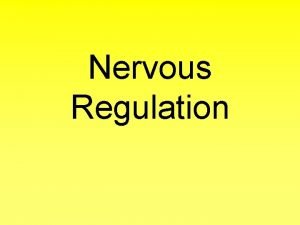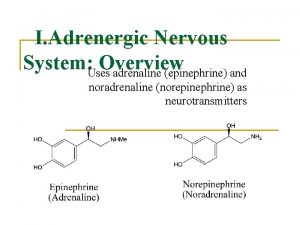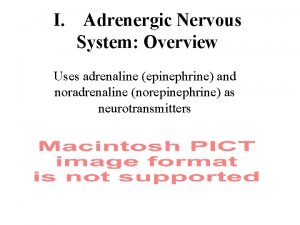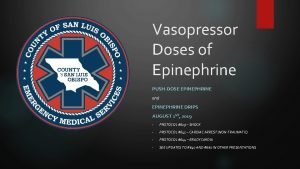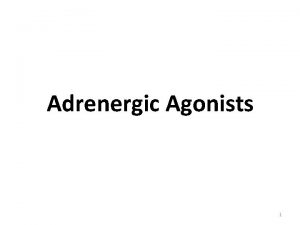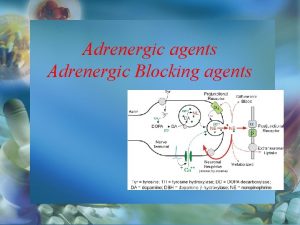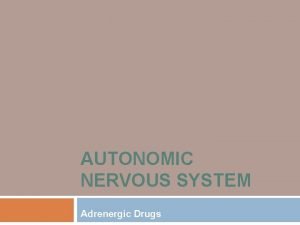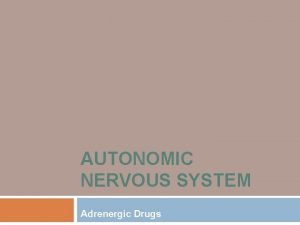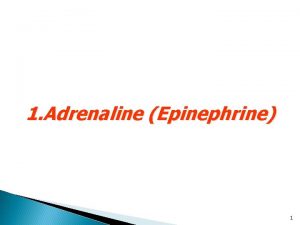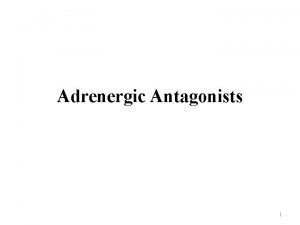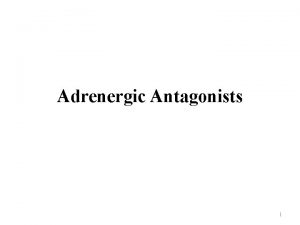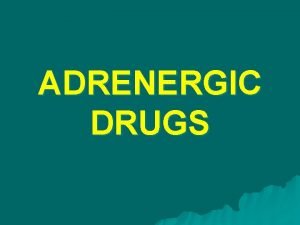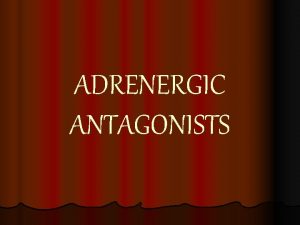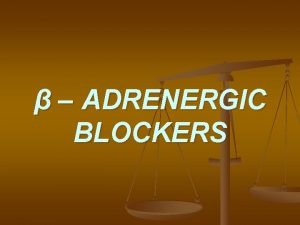I Adrenergic Nervous System Overview Uses adrenaline epinephrine











![• Epinephrine (INN) (IPA: [ˌɛpɪˈnɛfrən]) or adrenaline (European Pharmacopoeia and BAN) (IPA: [əˈdrɛnələn]), • Epinephrine (INN) (IPA: [ˌɛpɪˈnɛfrən]) or adrenaline (European Pharmacopoeia and BAN) (IPA: [əˈdrɛnələn]),](https://slidetodoc.com/presentation_image_h/838f0216a0872c07997933d6620214a5/image-12.jpg)









































![-blocker design • Propranolol (INN) (IPA: [proˈprセnəloʊl]) is a nonselective beta blocker mainly -blocker design • Propranolol (INN) (IPA: [proˈprセnəloʊl]) is a nonselective beta blocker mainly](https://slidetodoc.com/presentation_image_h/838f0216a0872c07997933d6620214a5/image-54.jpg)

















- Slides: 71

I. Adrenergic Nervous System: Overview Uses adrenaline (epinephrine) and noradrenaline (norepinephrine) as neurotransmitters


http: //www. sickkids. on. ca/childphysiology/cpwp/Urinary/kidney. swf http: //en. wikipedia. org/wiki/Adrenal_gland

Fight or Flight? • The fight-or-flight response, also called the acute stress response, was first described by Walter Cannon in 1929. His theory states that animals react to threats with a general discharge of the sympathetic nervous system, priming the animal for fighting or fleeing. This response was later recognized as the first stage of a general adaptation syndrome that regulates stress responses among vertebrates and other organisms. • Normally, when a person is in a serene, unstimulated state, the "firing" of neurons in the locus ceruleus is minimal. A novel stimulus (which could include a perception of danger or an environmental stressor signal such as elevated sound levels or over-illumination), once perceived, is relayed from the sensory cortex of the brain through the thalamus to the brain stem. That route of signaling increases the rate of noradrenergic activity in the locus ceruleus, and the person becomes alert and attentive to the environment. Similarly, an abundance of catecholamines at neuroreceptor sites facilitates reliance on spontaneous or intuitive behaviors often related to combat or escape. If a stimulus is perceived as a threat, a more intense and prolonged discharge of the locus ceruleus activates the sympathetic division of the autonomic nervous system (Thase & Howland, 1995). This activation is associated with specific physiological actions in the system, both directly and indirectly through the release of epinephrine (adrenaline) and to a lesser extent norepinephrine from the medulla of the adrenal glands. The release is triggered by acetylcholine released from preganglionic sympathetic nerves. The other major player in the acute stress response is the hypothalamic-pituitary-adrenal axis.

Fight or Flight Response: • These catecholamine hormones facilitate immediate physical reactions associated with a preparation for violent muscular action. (Gleitman, et al, 2004). These include the following: • ・Acceleration of heart and lung action・Inhibition of stomach and intestinal action ・Constriction of blood vessels in many parts of the body ・Liberation of nutrients for muscular action ・Dilation of blood vessels for muscles ・Inhibition of tear glands and salivation ・Dilation of pupil ・Relaxation of bladder ・Inhibition of erection • •

Adrenergic Receptors • In 1948, adrenergic receptors were subdivided into alpha and beta by Ahlquist. The distinction was based on sensitivities of different organs to catecholamines of closely related structure. Regulation of the functions of different organs depends to a greater or lesser extent on alpha or beta receptors. • Alpha receptors are located postsynaptically at sympathetic neuroeffector junctions of many organs. In general, alpha receptors mediate excitation or increased activity of the effector cells. Vascular smooth muscle is an important site of alpha receptors. SNS activity maintains vascular tone, and thus blood pressure, by maintaining a tone of neurotransmitter on vascular alpha receptors. • Beta receptors are also located postsynaptically at sympathetic neuroeffector junctions of many organs. In general, beta receptors mediate relaxation or decreased activity of the effector cells. Thus, blood vessels dilate and uterine smooth muscle relaxes in response to activation of beta receptors. Heart muscle is an important exception to this rule. Activation of beta adrenoceptors in heart increases the automaticity and contractility of all parts of the heart.

Types of -adrenergic receptor • -adrenergic receptors are adrenergic receptors that respond to norepinephrine and to such blocking agents as phenoxybenzamine. • They are subdivided into two types: • 1, found in smooth muscle, heart, and liver, with effects including vasoconstriction, intestinal relaxation, uterine contraction and pupillary dilation, • 2, found in platelets, vascular smooth muscle, nerve termini, and pancreatic islets, with effects including platelet aggregation, vasoconstriction, and inhibition of norepinephrine release and of insulin secretion.

-receptor types • -adrenergic receptors respond particularly to epinephrine and to such blocking agents as propranolol. • There are three known types of beta receptor, designated β 1, β 2 and β 3. • β 1 -Adrenergic receptors are located mainly in the heart. • β 2 -Adrenergic receptors are located mainly in the lungs, gastrointestinal tract, liver, uterus, vascular smooth muscle, and skeletal muscle. • β 3 -receptors are located in fat cells.

What do the receptors do? Activation of receptors leads to smooth muscle contraction Activation of 2 receptors leads to smooth muscle relaxation Activation of 1 receptors leads to smooth muscle contraction (especially in heart)

Clinical Utility of drugs which affect the adrenergic nervous system: a. Agonists of the 2 receptors are used in the treatment of asthma (relaxation of the smooth muscles of the bronchi) b. Antagonists of the 1 receptors are used in the treatment of hypertension and angina (slow heart and reduce force of contraction) c. Antagonists of the 1 receptors are known to cause lowering of the blood pressure (relaxation of smooth muscle and dilation of the blood vessels)

Definitions • Sympathetic and parasympathetic divisions typically function in opposition to each other. But this opposition is better termed complementary in nature rather than antagonistic. For an analogy, one may think of the sympathetic division as the accelerator and the parasympathetic division as the brake. • The sympathetic division typically functions in actions requiring quick responses. • The parasympathetic division functions with actions that do not require immediate reaction. • Consider sympathetic as "fight or flight" and parasympathetic as "rest and digest".
![Epinephrine INN IPA ˌɛpɪˈnɛfrən or adrenaline European Pharmacopoeia and BAN IPA əˈdrɛnələn • Epinephrine (INN) (IPA: [ˌɛpɪˈnɛfrən]) or adrenaline (European Pharmacopoeia and BAN) (IPA: [əˈdrɛnələn]),](https://slidetodoc.com/presentation_image_h/838f0216a0872c07997933d6620214a5/image-12.jpg)
• Epinephrine (INN) (IPA: [ˌɛpɪˈnɛfrən]) or adrenaline (European Pharmacopoeia and BAN) (IPA: [əˈdrɛnələn]), sometimes spelled "epinephrin" or "adrenalin" respectively, is a hormone. It is a catecholamine, a sympathomimetic monoamine derived from the amino acids phenylalanine and tyrosine. • The Latin roots ad-+renes and the Greek roots epi-+nephros both literally mean "on/to the kidney" (referring to the adrenal gland, which secretes epinephrine). Epinephrine is sometimes shortened to epi in medical jargon. • Epinephrine is now also used in Epi. Pens and Twinjects. Epi. Pens are long narrow autoinjectors that administer epinephrine, Twinjects are similar but contain two doses of epinephrine. Though both Epi. Pen and Twinject are trademark names, common usage of the terms are drifting toward the generic context of any epinephrine autoinjector.

http: //www. maxanim. com/biochemistry/Epinephrine/Epin ephrine. htm

Epi. Pen is a registered trademark for the most commonly used autoinjector of epinephrine (aka adrenaline), used in medicine to treat anaphylactic shock. http: //www. epipen. com/howtouse_high. aspx

Anaphylaxis is a severe and rapid multi-system allergic reaction. The term comes from the Greek words ana (against) and phyllus (protection). Anaphylaxis occurs when a person is exposed to a trigger substance, called an allergen, to which they have already become sensitized. Minute amounts of allergens may cause a life-threatening anaphylactic reaction. Anaphylaxis may occur after ingestion, inhalation, skin contact or injection of an allergen. The most severe type of anaphylaxis—anaphylactic shock—will usually lead to death in minutes if left untreated. Most common presentation is sudden cardiovascular collapse (88% of reported cases of severe anaphylaxis).

Anaphylactic shock, the most serious of allergic reactions, is a life-threatening medical emergency because of rapid constriction of the airway, often within minutes of onset. Calling for help immediately is important, as brain and organ damage rapidly occurs if the patient cannot breathe. Anaphylactic shock requires immediate advanced medical care; but other first aid measures include rescue breathing (part of CPR) and administration of epinephrine (adrenaline). Rescue breathing may be hindered by the constricted airways but is essential if the victim stops breathing on their own. If the patient has previously been diagnosed with anaphylaxis, they may be carrying an Epi. Pen (or similar device) for immediate administration of epinephrine (adrenaline) by a layperson to help keep the airway open. Use of an Epi. Pen or similar device will only provide temporary and limited relief of symptoms, so emergency medical services must still be contacted. Repetitive administration of epinephrine can cause tachycardia (rapid heartbeat) and occasionally ventricular tachycardia with heart rates potentially reaching 240 beats per minute, which can also be fatal. Extra doses of epinephrine can sometimes cause cardiac arrest. This is why some protocols advise intramuscular injection of only 0. 3– 0. 5 m. L of a 1: 1, 000 dilution. The epinephrine will prevent worsening of the airway constriction, stimulate the heart to continue beating, and may be life-saving.

Ephinephrine can be injected directly into the heart to stimulate it after it as stopped beating due to drowning, suffocation, shock, electrocution, and anesthesia. The epinephrine dramatically restores the heart beat. In cases of shock, norepinephrine has been used to restore and maintain sufficient blood pressure and ensure adequate blood flow to vital organs. When local anesthetics are used to reduce or eliminate pain in a specific area, epinephrine is frequently used in conjunction with these agents to constrict the blood vessels at the area and prevent drug diffusion from that area


Endocrine Glands (general) • http: //pennhealth. com/health_info/anima tionplayer/endocrine_glands. html

Adrenal Gland • http: //health. howstuffworks. com/adam 200053. htm • http: //en. wikipedia. org/wiki/Image: Illu_a drenal_gland. jpg • http: //www. answers. com/topic/adrenalgland


Biosynthesis of norepinephrine and epinephrine

Metabolism involves two key enzymes: MAO and COMT

The design of a drug to treat asthma • Asthma is a chronic disease of the respiratory system in which the airway occasionally constricts, becomes inflamed, and is lined with excessive amounts of mucus, often in response to one or more triggers. These acute episodes may be triggered by such things as exposure to an environmental stimulant (or allergen), cold air, exercise or exertion, or emotional stress. In children, the most common triggers are viral illnesses such as those that cause the common cold. [1] This airway narrowing causes symptoms such as wheezing, shortness of breath, chest tightness, and coughing, which respond to bronchodilators. Between episodes, most patients feel fine. The disorder is a chronic or recurring inflammatory condition in which the airway develops increased responsiveness to various stimuli, characterized by bronchial hyper-responsiveness, inflammation, increased mucus production, and intermittent airway obstruction. The symptoms of asthma, which can range from mild to life threatening, can usually be controlled with a combination of drugs and environmental changes. Public attention in the developed world has recently focused on asthma because of its rapidly increasing prevalence, affecting up to one in four urban children. [2]

What is asthma? • http: //www. 1 on 1 health. com/web/info/asthma/english/asthmaanimation/Animation. Page/Look. Listen. Learn. Type=1 • http: //www. whatsasthma. org/flash/hasthmav. html • http: //www. healthcentral. com/animation/408/46. html What is COPD? http: //allergy. health. ivillage. com/animations/show_animations. cfm? cmbtopics=210 http: //www. exploriaproductions. com/movies/IVAX_320 x 240. mov

COPD • Chronic obstructive pulmonary disease (COPD), also known as chronic obstructive airway disease (COAD), is a group of diseases characterised by limitation of airflow in the airway that is not fully reversible. COPD is the umbrella term for chronic bronchitis and/or emphysema. It is most often due to tobacco smoking [1] but can be due to other airborne irritants such as coal dust or solvents. Chronic Bronchitis Chronic bronchitis is defined in clinical terms as a cough with sputum production on most days for 3 months of a year, for 2 consecutive years. [6] Chronic bronchitis is hallmarked by the increased number (hyperplasia) and increased size (hypertrophy) of the mucus-secreting (goblet) cells of the airway. This, along with enlargement of the mucous gland, results in an increase in production of mucus which contributes to the airway obstruction. Microscopically there is infiltration of the airway walls with inflammatory cells, particularly neutrophils. Inflammation is followed by scarring and remodelling that thickens the walls resulting in narrowing of the small airway. Further progression leads to an abnormal change (metaplasia) in the nature of the tissue along with further thickening and scarring ( fibrosis) of the lower airway. The consequence of these changes is a limitation of airflow. [7] Emphysema Main article: Emphysema is defined histologically as the enlargement of the air spaces distal to the terminal bronchioles, with destruction of their walls. [6] The enlarged air sacs (alveoli) of the lungs reduces the surface area available for the movement of gases during respiration. This can cause breathlessness in severe cases. The exact mechanism for the development of emphysema is not understood, although it it known to be linked with smoking and age.

Historically, what therapeutic agents have been used? • Ephedrine, as part of the Chinese medicine Ma Huang, has been used in the treatment of respiratory diseases for over 5000 years • Ephedrine is now known to act indirectly, by releasing endogenous catecholamines, resulting in bronchodilation • In 1900, Solis-Cohen showed that orally administered adrenal extract was beneficial in asthma.

Historic • Initially, subcutaneous injections of epinephrine were used, followed by a nebulized epinephrine solution. • Epinephrine is one of the most potent vasopressor (i. e. causes constriction of the blood vessels and corresponding rise in blood pressure) drugs known. • Epinephrine affects respiration primarily by relaxing the bronchial muscle. • Epinephrine is rapidly metabolized by COMT, primarily in the liver.

Can we make an asthma drug with less side effects, and longer lasting? • Clues: • It is known that the 2 receptor is the target for relaxation of bronchial smooth muscle. • Epinephrine has approx. equal affinity for both and receptors • However norepinephrine has greater affinity for the receptors • This indicates that placing an alkyl group on the nitrogen leads to an increase in selectivity for the -receptors.

Equal selectivity for Both and -receptors Greater selectivity for receptors Perhaps, still greater selectivity for -receptors could be Generated by appending larger alkyl substituent on nitrogen

An improvement! • Isoprenaline was synthesized by German chemists in the 1940’s • It had less cardiovacular side effects than adrenaline • Became the most widely used inhaled treatment for asthma for the next 20 years.

Further improvements needed • Needed an agent which was longer lasting, more resistant to COMT • Needed an agent which was more selective for the 2 receptors in the lung and less selective for the 1 receptors of heart.

Arrives Salbutamol • Tert-butyl group renders salbutamol more selective for 2 • Hydroxymethyl group (in place of OH) renders salbutamol resistant to COMT • Remains the most widely used anti-asthma drug in the world

Salbutamol • Salbutamol (INN) or albuterol (USAN) is a short-acting β 2 adrenergic receptor agonist used for the relief of bronchospasm in conditions such as asthma and COPD. Salbutamol sulphate is usually given by the inhaled route for direct effect on bronchial smooth muscle. This is usually achieved through a metered dose inhaler (MDI), nebuliser or other proprietary delivery devices (e. g. Rotahaler or Autohaler). In these forms of delivery, the effect of Salbutamol can take place within 5 to 20 minutes of dosing. Salbutamol can also be given orally or intravenously. However, some asthmatics may not respond to these medications as they will not have the required DNA base sequence in a specific gene. Salbutamol became available in the United Kingdom in 1969 and in the United States in 1980 under the trade name Ventolin.

Salmeterol is a long-acting beta 2 -adrenergic receptor agonist drug that is currently prescribed for the treatment of asthma and chronic obstructive pulmonary disease COPD. It is currently available in both dry-powder inhalers (DPIs) and pressurised metered dose inhalers (p. MDIs). It is a long acting beta-adrenoceptor agonist (LABA), usually only prescribed for severe persistent asthma following previous treatment with a short-acting beta agonist such as salbutamol and is prescribed concurrently with a corticosteroid, such as beclometasone. The primary noticeable difference of salmeterol to salbutamol is that the duration of action lasts approximately 12 hours in comparison with 4ミ 6 hours of salbutamol.

BRONCHODILATORS, ADRENERGIC (Inhalation)* In the U. S. Adrenalin Chloride 3 Airet 1 Alupent 8 Arm-a-Med Isoetharine 6 Arm-a-Med Metaproterenol 8 Asthmahaler Mist 3 Asthma. Nefrin 3 Beta-2 6 Brethaire 12 Bronkaid Mist 3 Bronkaid Suspension Mist 3 Bronkometer 6 Bronkosol 6 Dey-Lute Isoetharine 6 Dey-Lute Metaproterenol 8 Foradil 5 Isuprel 7 Isuprel Mistometer 7 Maxair 9 Maxair Autohaler 9 Medihaler-Iso 7 micro. Nefrin 3 Nephron 3 Primatene Mist 3 Proventil 1 Proventil HFA 1 S-2 3 Serevent Diskus 11 Vaponefrin 3 Ventolin 1 Ventolin HFA 1 Ventolin Nebules 1 Ventolin Rotacaps 1 In Canada. Alupent 8 Apo-Salvent 1 Berotec 4 Bricanyl Turbuhaler 12 Bronkaid Mistometer 3 Foradil 5 Gen-Salbutamol Sterinebs P. F. 1 Isuprel 7 Isuprel Mistometer 7 Maxair 9 Novo-Salmol 1 Oxeze Turbuhaler 5 Pro-Air 10 Serevent 11 Serevent Diskhaler 11 Serevent Diskus 11 Vaponefrin 3 Ventodisk 1 Ventolin Nebules P. F. 1 Ventolin Rotacaps 1 This information applies to the following medicines: 1. Albuterol (al-BYOO-ter-ole)‡§ 2. Bitolterol (bye-TOLE-ter-ole)*† 3. Epinephrine (ep-i-NEF-rin)‡ 4. Fenoterol (fen-OH-ter-ole)* 5. Formoterol (for-MOH-ter-ol))‡§ 6. Isoetharine (eye-soe-ETH-a-reen)†‡ 7. Isoproterenol (eye-soe-proe-TER-e-nole)‡ 8. Metaproterenol (met-a-proe-TER-e-nole)‡ 9. Pirbuterol (peer-BYOO-ter-ole) 10. Procaterol (proe-KAY-ter-ole)* 11. Salmeterol# (sal-ME-te-role)* 12. Terbutaline (ter-BYOO-ta-leen)

Treatment of COPD • Bronchodilators. There are three types of bronchodilators used clinically: β 2 -agonists, anticholinergics and methylxanthines. [8]These drugs relax the smooth muscles of the airway allowing for improved airflow. Many patients feel less breathless after taking bronchodilators.

Combivent® Salbutamol / Ipratropium bromide Presentation Inhaler 100 mcg / 20 mcg per inhalation Combivent metered dose inhaler has an opaque shaft with a grey mouthpiece and cap. The canister contains a creamy-white homogenous suspension of micronised substances in a chlorofluorohydrocarbon propellant mixture filled in an aluminium canister with a metering valve. Each metered dose contains salbutamol 100 mcg (equivalent to 120 mcg salbutamol sulphate), and ipratropium bromide 20 mcg (equivalent to 21 mcg of ipratropium bromide monohydrate). Respules® 2. 5 mg / 500 mcg in 2. 5 ml Combivent 2. 5 ml Respule contains an isotonic, clear, preservative-free solution for inhalation of 2. 5 mg salbutamol (equivalent to 3. 01 mg salbutamol sulphate) and 500 mcg ipratropium bromide anhydrous (equivalent to 520 mcg ipratropium bromide monohydrate) Uses Actions Combivent contains two active bronchodilating substances, salbutamol sulphate and ipratropium bromide. Salbutamol sulphate is a beta 2 -adrenergic agent which acts on airway smooth muscle resulting in relaxation. Salbutamol relaxes all smooth muscle from the trachea to the terminal bronchioles and protects against all bronchoconstrictor challenges. Ipratropium bromide is a quaternary ammonium compound with anticholinergic properties. In preclinical studies, it appears to inhibit vagally mediated reflexes by antagonising the action of acetylcholine, the transmitter agent released from the vagus nerve. Anticholinergics prevent the increase of intracellular concentration of cyclic guanosine monophosphate (cyclic GMP) caused by interaction of acetylcholine with muscarinic receptors on bronchial smooth muscle. The bronchodilation following inhalation of ipratropium bromide is primarily local and site specific to the lung and not systemic in nature. Combivent provides the simultaneous release of ipratropium bromide and salbutamol allowing the synergistic efficacy on the muscarinic and beta 2 -adrenergic receptors in the airways to cause bronchodilation which is superior to that provided by each single agent and with no potentiation of adverse

Cholinergic Antagonists (Muscarinic receptor) Ipratropium (bronchodilator & anti-asthmatic)

Adrenergic Receptors in the CNS • http: //www. brainexplorer. org/video/index. shtml

-Blockers • Alpha blockers (also called alpha-adrenergic blocking agents) constitute a variety of drugs which block α 1 adrenergic receptors in arteries and smooth muscles. • These drugs may be used to treat: ・benign prostatic hyperplasia (BPH)・high blood pressure (hypertension). This is not typically the drug of choice unless the patient also has BPH. ・symptoms of non inflammatory chronic pelvic pain syndrome, a type of prostatitis. As a side effect they may reduce blood pressure and result in lightheadedness.

Benign Prostatic Hyperplasia • http: //www. muschealth. com/gs/Animatio n. List. aspx#anim 4 • http: //health. howstuffworks. com/adam 200003. htm

Treatment of benign prostatic hyperplasia (BPH) Medications Alpha blockers (α 1 -adrenergic receptor antagonists) (such as doxazosin, prazosin, alfuzosin and tamsulosin) and certain antiandrogens such as the 5α-reductase inhibitors (finasteride and dutasteride) are used, often together, in suppressing the symptoms. Alpha-blockers relax smooth muscle in the prostate and bladder neck decreasing the degree of blockage of urine flow. Alpha-blockers may cause ejaculation back into the bladder (retrograde ejaculation). This is not harmful. There is also extensive evidence of the efficacy of Serenoa repens (saw palmetto) fruit extracts in alleviating mild-to-moderate BPH symptoms. A systematic review of evidence found comparable efficacy to finasteride. (Wilt et al. , 2002) Other herbal medicines that have solid research support in systematic reviews include beta-sitosterol from Hypoxis rooperi (African star grass) and Prunus africanum (pygeum) bark, while there is less substantial support for the efficacy of Cucurbita pepo (pumpkin) seed and Urtica dioica (stinging nettle) root. (Wilt et al. , 2000) At least one double-blind trial has also supported the efficacy of rye flower pollen. (Buck, et al. , 1990) Sildenafil shows some symptomatic relief, suggesting a possible common etiology with erectile disfunction. (Brown 2005)o

Examples of commercial -blockers

-Blockers • Beta blockers (sometimes written as β-blockers) are a class of drugs used for various indications, but particularly for the management of cardiac arrhythmias and cardioprotection after myocardial infarction. Whilst once first-line treatment for hypertension, their role was downgraded in June 2006 in the United Kingdom to fourth-line as they perform less well than other drugs, particularly in the elderly, and there is increasing evidence that the most frequently used beta-blockers at usual doses carry an unacceptable risk of provoking type 2 diabetes. [1]

Hypertension • http: //www. healthscout. com/animation/6 8/47/main. html

What are -blockers used for? • Numerous studies suggest that beta-blockers can reduce mortality by 25% to 40% in patients with certain kinds of heart failure, and cut sudden cardiac death up to 50% in patients with a recent heart attack. • Current Uses • Treatment・Angina pectoris (chest pain associated with lack of oxygen to the heart)・Arrhythmias (irregular heart rhythms)・Heart attack・Heart failure・Hypertension (high blood pressure) • Prevention・Protects the heart in people who have coronary artery disease・Reduces risk of stroke・ Protective prior to non-cardiac surgery in persons at high risk of complications

Heart Failure • http: //www. healthscout. com/animation/6 8/13/main. html • http: //www. medindia. net/animation/hear t_attack. asp

How do -blockers work? • • • Mechanism for How It Works・Beta-blockers "block" the effects of adrenaline on your body's beta-receptors. This slows the nerve impulses that travel through the heart. As a result, your heart does not have to work as hard because it needs less blood and oxygen. This decreases heart rate, blood pressure, and lessens the need for nitrates. Beta-blockers also block the impulses that can cause an arrhythmia (abnormal heart beat). ・ Beta-blockers generally work by affecting the response to some nerve impulses. Your body has 2 main beta-receptors: beta 1 and beta 2. Some beta-blockers are selective, which means that they block beta 1 receptors more than they block beta 2 receptors. Beta 1 receptors are responsible for heart rate and the strength of your heartbeat. Nonselective beta-blockers block both beta 1 and beta 2 receptors. Beta 2 receptors are responsible for the function of your smooth muscles (muscles that control body functions but that you do not have control over). ・ This class of drugs may decrease the sympathetic outflow from the central nervous system and/or suppress the release of reninムa substance that is elevated in some patients with high blood pressure and is involved in a cascade of events leading to constriction of blood vessels. In addition, some speculate that beta-blockers may have possible antioxidant and cholesterol lowering effects.

Strategy for design of -blockers • Begin design by identifying a molecule selective for -receptors • For example, we discussed the following molecule, which is a reasonably selective agonist (e. g. isoprenaline)

Design of -blockers • Remove phenolic OH groups, which are necessary for -agonism

-blocker design • Replace two chlorine atoms with a fused aryl ring • Resulted in a partial agonist, which partially blocked effect of epinephrine

-blocker design • Next extend the side chain to try and achieve “umbrella” effect • Serendipity comes into play, as one synthetic intermediate is not available in the research lab, another is used, and a drug is discovered.
![blocker design Propranolol INN IPA proˈprセnəloʊl is a nonselective beta blocker mainly -blocker design • Propranolol (INN) (IPA: [proˈprセnəloʊl]) is a nonselective beta blocker mainly](https://slidetodoc.com/presentation_image_h/838f0216a0872c07997933d6620214a5/image-54.jpg)
-blocker design • Propranolol (INN) (IPA: [proˈprセnəloʊl]) is a nonselective beta blocker mainly used in the treatment of hypertension. It was the first successful beta blocker developed. Propranolol is commonly marketed by Astra. Zeneca under the trade name Inderal. • Scottish scientist James W. Black successfully developed propranolol in the late 1950 s. He was awarded the Nobel Prize in Medicine for this discovery in 1988.

Examples of beta blockers Dichloroisoprenaline, the first beta blocker. Alprenolol Carteolol Levobunolol Mepindolol Metipranolol Nadolol Oxprenolol Penbutolol Pindolol Propranolol Sotalol Timolol [edit]β 1 -Selective agents Acebutolol Atenolol Betaxolol Bisoprolol Esmolol Metoprolol Nebivolol [edit]Mixed α 1/β-adrenergic antagonists Carvedilol Celiprolol Labetalol�� �耀Ό�楯� ���� ��

Some -blockers are also used to treat glaucoma http: //www. goodhope. org. uk/departments/eyedept/images/gl aucoma. html http: //www. goodhope. org. uk/departments/eyedept/angleclosu reetc. htm http: //www. goodhope. org. uk/departments/eyedept/dropsfor. h tm

Non-specific -blockers (antagonize both 1 and 2 receptors)

Selective ( 1 selective) -blockers

Why do you want selective antagonists? • Acebutolol is a cardioselective beta blocker. It is more suitable than non cardioselective beta blockers, if a patient with Asthma bronchiale or chronic obstructive lung disease (COLD) needs treatment with a beta blocker.

Non-selective -blockers which also antagonize at the 1 receptor

Why add 1 antagonism? • In addition to blocking both β 1 - and β 2 adrenergic receptors, carvedilol also displays α 1 -adrenergic antagonism, which confers the added benefit of reducing blood pressure through vasodilation.

Biosynthesis of norepinephrine and epinephrine

A competitive inhibitor of tyrosine hydroxylase can be used to slow production of catecholamines

Inhibition of catecholamine synthesis • -methyltyrosine is occasionally used to treat hypertension associated with tumors in the adrenal medulla

Reserpine • Reserpine was isolated in 1952 from the dried root of Rauwolfia serpentina (Indian snakeroot), [4] and introduced in 1954, two years after chlorpromazine. [5] Reserpine almost irreversibly blocks the uptake (and storage) of noradrenaline and dopamine into synaptic vesicles by inhibiting the Vesicular Monoamine Transporters (VMAT). [6] In so doing, it leaves the noradrenaline in the cytoplasm, where it is destroyed by monamine oxidase (MAO). It was once used to treat hypertension, but has many side effects, including depression, stomach cramps, diarrhea, etc.

Norepinephrine Reuptake Inhibitors as Antidepressants • Norepinephrine reuptake inhibitors (NRIs), also known as noradrenaline reuptake inhibitors (NARIs), are compounds that elevate the extracellular level of the neurotransmitter norepinephrine in the central nervous system by inhibiting its reuptake from the synaptic cleft into the presynaptic neuronal terminal. The drugs inhibit the class of neurotransmitter transporters known as norepinephrine transporters. They have virtually no action at other monoamine transporters.

Depression • http: //www. healthcentral. com/depressio n/introduction-5003 -109. html • http: //www. healthscout. com/animation/6 8/10/main. html

What is serotonin? In the central nervous system, serotonin is believed to play an important role in the regulation of body temperature, mood, sleep, vomiting, sexuality, and appetite. Low levels of serotonin have been associated with several disorders, namely clinical depression, obsessivecompulsive disorder (OCD), migraine, irritable bowel syndrome, tinnitus, fibromyalgia, bipolar disorder, and anxiety disorders. [citation needed] If neurons of the brainstem that make serotonin—serotonergic neurons—are abnormal, there is a risk of sudden infant death syndrome (SIDS) in an infant. [1]

Understanding Serotonin • The pharmacology of 5 -HT is extremely complex, with its actions being mediated by a large and diverse range of 5 -HT receptors. At least seven different receptor "families" are known to exist, each located in different parts of the body and triggering different responses. As with all neurotransmitters, the effects of 5 -HT on the human mood and state of mind, and its role in consciousness, are very difficult to ascertain.

Understanding Serotonin • Serotonergic action is terminated primarily via uptake of 5 -HT from the synapse. This is through the specific monoamine transporter for 5 -HT, 5 -HT reuptake transporter, on the presynaptic neuron. Various agents can inhibit 5 -HT reuptake including MDMA (ecstasy), cocaine, tricyclic antidepressants (TCAs) and selective serotonin reuptake inhibitors (SSRIs). Recent research suggests that serotonin plays an important role in liver regeneration and acts as a mitogen (induces cell division) throughout the body. [6]

Norepinephrin Reuptake Inhibitors for Depression • Atomoxetine is classified as a norepinephrine reuptake inhibitor, and is approved for use in children, adolescents, and adults. • Atomoxetine is the first non-stimulant drug approved for the treatment of attention-deficit hyperactivity disorder (ADHD). It is sold in the form of the hydrochloride salt of atomoxetine. It is manufactured and marketed under the brand name Stratteraィ by Eli Lilly and Company as a generic Attentin by Torrent Pharmaceuticals. There is currently no generic available within the United States due to patent restrictions.
 Adrenaline is also known as
Adrenaline is also known as Neural circuits the organization of neuronal pools
Neural circuits the organization of neuronal pools Fundamentals of the nervous system and nervous tissue
Fundamentals of the nervous system and nervous tissue Neuronal pools are collections of
Neuronal pools are collections of Racemic epinephrine
Racemic epinephrine Pediatric epinephrine dose chart
Pediatric epinephrine dose chart Epinephrine cascade
Epinephrine cascade Epinephrine function
Epinephrine function Lateral thigh injection site
Lateral thigh injection site Norepinephrine function
Norepinephrine function Racemic epinephrine
Racemic epinephrine Hypothalamus epinephrine
Hypothalamus epinephrine Epinephrine second dose
Epinephrine second dose Expressed consent
Expressed consent Epinephrine and norepinephrine feedback loop
Epinephrine and norepinephrine feedback loop Http://learn.genetics.utah.edu/content/addiction/
Http://learn.genetics.utah.edu/content/addiction/ How to draw up epinephrine
How to draw up epinephrine Adrenaline and memory
Adrenaline and memory How to calculate empirical formula with percentages
How to calculate empirical formula with percentages How to calculate mean arterial pressure
How to calculate mean arterial pressure Cpr adrenaline dose
Cpr adrenaline dose Adrenaline intra tracheale
Adrenaline intra tracheale Noradrenaline adrenaline
Noradrenaline adrenaline Which sequence represents structures organized
Which sequence represents structures organized Atenolol to carvedilol conversion chart
Atenolol to carvedilol conversion chart Noradrenaline dose calculation formula
Noradrenaline dose calculation formula Module soins infirmiers de base
Module soins infirmiers de base Sympathomimetic effects
Sympathomimetic effects Adrenergic agonist
Adrenergic agonist Difference between alpha and beta receptors
Difference between alpha and beta receptors Cholinergic drugs act on receptors normally stimulated by:
Cholinergic drugs act on receptors normally stimulated by: Terminal ganglia
Terminal ganglia Cholinergic vs adrenergic
Cholinergic vs adrenergic Beta blockers moa
Beta blockers moa Opposite of adrenergic
Opposite of adrenergic Adrenergic receptors
Adrenergic receptors Opposite of adrenergic
Opposite of adrenergic Alpha adrenergic agonist
Alpha adrenergic agonist Alpha vs beta agonist
Alpha vs beta agonist Adrenergic neuron blockers
Adrenergic neuron blockers Non selective bb
Non selective bb Adverse effect of alpha blockers
Adverse effect of alpha blockers Sympatholytic drugs classification
Sympatholytic drugs classification Structure activity relationship of sympathomimetic drugs
Structure activity relationship of sympathomimetic drugs Adrenergic and cholinergic difference
Adrenergic and cholinergic difference Nervous system and digestive system
Nervous system and digestive system Endocrine system and nervous system
Endocrine system and nervous system Amino acid-based hormones
Amino acid-based hormones Adh function
Adh function Chemical messengers of the nervous system
Chemical messengers of the nervous system Platyhelminthes classification
Platyhelminthes classification The nervous system is made up of
The nervous system is made up of What are the three basic functions of the nervous system
What are the three basic functions of the nervous system Nervous system learning objectives
Nervous system learning objectives Bipolar neuron function
Bipolar neuron function Stimulus in nervous system
Stimulus in nervous system Objectives of nervous system
Objectives of nervous system Craniosacral region
Craniosacral region Nervous system def
Nervous system def Plexuses
Plexuses Sns somatic nervous system
Sns somatic nervous system Brain scienstructable
Brain scienstructable Skeletal muscle autonomic nervous system
Skeletal muscle autonomic nervous system Roundworms nervous system
Roundworms nervous system Arthropods circulatory system
Arthropods circulatory system Nervous system of arthropods
Nervous system of arthropods Segmented coelomates
Segmented coelomates Nervous system major divisions
Nervous system major divisions Parasympathatic nervous system
Parasympathatic nervous system Coelenterata nervous system
Coelenterata nervous system Autonomic nervous system consists of
Autonomic nervous system consists of Differences between nervous system and endocrine
Differences between nervous system and endocrine
